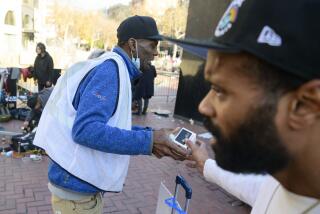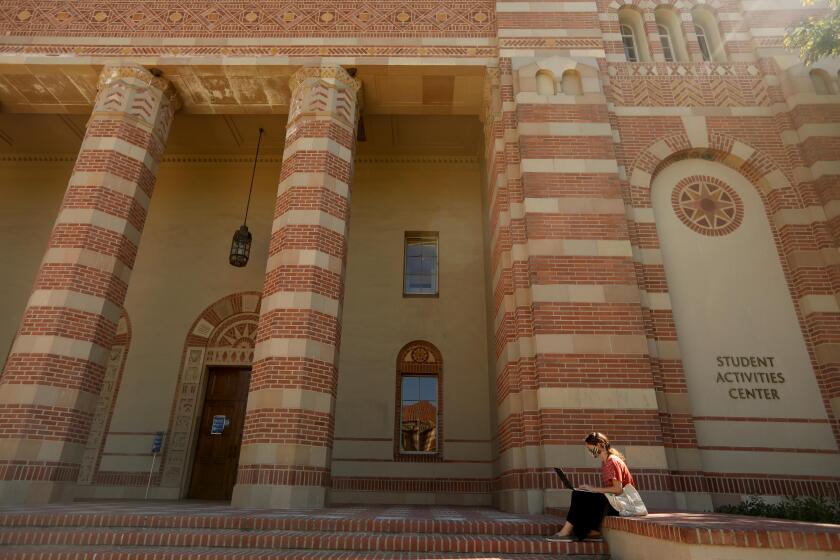California and the West : S.F. Reports Upsurge in Risky Sex by Gay Men : Health: Trend worries AIDS prevention officials, who say old education efforts no longer work. Others say adults should be left to negotiate intimate aspects of their lives.
- Share via
SAN FRANCISCO — In the 1980s, the message health officials put out to the gay community was simple, straightforward and effective: If you are going to have sex, use a condom, every time.
“It was the old health education model,” recalled Linda Fisher-Ponce, who was then an HIV counselor with the city of San Francisco. “Someone would stand in the front of the room with an easel and colored chalk and do a group session.”
Health officials and AIDS activists agree that the message worked astonishingly well. Gay men radically altered their sexual behavior, and the rate of new HIV infections declined steeply.
But here in the city that for so long has been ground zero in the fight against AIDS, it came as no surprise when studies presented during a government-sponsored forum on HIV prevention in Atlanta last week showed there has been a disturbing upsurge in risky sexual practices among gay men. The Centers for Disease Control and Prevention urged a greater emphasis on prevention.
In San Francisco, AIDS organizations say, it isn’t easy to come up with effective messages for a gay community whose culture has drastically changed since the AIDS crisis began. Some gay men here are pushing to reopen bathhouses, closed by the city in the 1980s, and want to ease restrictions on sex clubs that now require men to have sex in communal rooms, where they can be monitored by staff to ensure that they are using condoms.
Others say it is time for health officials to leave it to gay men to negotiate the most intimate aspects of their lives.
“People’s perceptions of HIV and AIDS are much different now from what they were then,” said Dr. Jeffrey Klausner, director of the Sexually Transmitted Disease Prevention and Control Services for San Francisco’s Department of Public Health. “Back then, their friends, lovers and cousins were dying and people were scared to death.”
Today, Klausner said, “people aren’t seeing people dying of AIDS, they aren’t seeing people sick from AIDS walking down the street.”
The San Francisco AIDS Foundation conducted in-depth surveys with 200 gay men from 1996 through 1998 and found that most were no longer listening to traditional prevention messages.
“What was clear from those interviews is that men were not paying attention at all to the primary prevention messages that were coming out of AIDS organizations. Use a condom every time? Forget it!” said Rene Durazzo, director of programs for the foundation.
Durazzo and other activists agree that unsafe sexual practices among gay men are on the rise, but they are quick to point out that their surveys show that most gay men still practice safe sex much of the time.
“I am always amazed that people are still . . . using them 100% of the time,” said Hank Tavera, a counselor in the city’s free clinic for sexually transmitted diseases. “Those are the unsung heroes and I see them every day.”
Dr. Ron Stall, an epidemiologist with UC San Francisco’s Center for AIDS Prevention, says many gay men are making informed choices to take calculated risks after decades of living with AIDS.
“There are groups of men who have thought about this a great deal and have decided: You can’t live in a crisis the rest of your life,” said Stall, who is gay. “They are choosing strategies that are not recommended by health care professionals.”
But Klausner worries that the willingness to engage in unsafe practices is moving from the fringe of gay culture to the mainstream.
This year, activists pushed hard to have the city bring back bathhouses. The issue became emotionally charged, with Dr. Mitchell Katz, director of the city’s Health Department and himself gay, being accused of homophobia for his insistence that the bathhouses remain closed.
The Health Department closed the bathhouses in 1984, fearful that they were a major source of transmission of AIDS because they featured private rooms where men sometimes had sex with strangers. The bathhouses were replaced with sex clubs, where men have sex in lighted, monitored rooms plastered with safe sex posters and stocked with condoms and lubricants.
Supporters of the bathhouses contend that the sex clubs “infantilize” gay men and rob them of dignity by denying them privacy. But the drive to put a measure on the November city ballot that would reopen bathhouses failed to secure enough signatures.
The dilemma for the city Health Department and the myriad private AIDS prevention organizations is how to tailor messages that will make sense to young gays, older gays, black and Latino gays.
Durazzo says the interviews with gays helped counselors fashion a new approach to prevention and a media campaign that it intends to launch in October.
In trying to understand “why men are letting go of the condom message,” Durazzo said, the foundation found “that we can no longer play the strict role of HIV educator. . . . We have to take a much broader role. We have to facilitate the conversations that men want to have about their lives and then let men figure out for themselves how they are going to stay healthy.”
Two years ago, the foundation launched a program called Gay Life. “When we rolled out the Gay Life campaign in the media, HIV was not prominent at all,” Durazzo said. The program offers workshops on issues such as aging, body image and loneliness.
Another San Francisco group, Stop AIDS, has decided to fashion new prevention messages aimed at specific groups. Marvin White, a gay black man, designed a program for black gays for the organization.
“I designed this program with me in mind,” White said. A workshop in August drew 45 black men to a day of poetry and song about dealing with HIV and AIDS.
The city’s sexually transmitted disease clinic also has changed its approach. Years ago, clients came in, were tested, got their results and received a 10-minute session on safe sex, Tavera said.
“That message is old, tired and too simplistic,” he said. “Now we dig deeper. I call it peeling the onion. We talk about what people perceive is putting them at risk. I try to find out what motivates people to do risky things and help them analyze that. I want them to walk out of here with a plan of action that helps them reduce risky behavior.”
But neither city officials nor AIDS activists feel they have yet hit on a truly effective approach.
“What I can say is that there is a lot of discussion,” Stall said. “A lot of talk around how prevention campaigns can be done in ways that will keep the most men uninfected as possible.”
“I can only hope,” said Klausner, “that in the past 18 years of being involved in this epidemic we’ve learned lessons that will help us to create new messages that are effective and not demeaning.”
More to Read
Sign up for Essential California
The most important California stories and recommendations in your inbox every morning.
You may occasionally receive promotional content from the Los Angeles Times.










